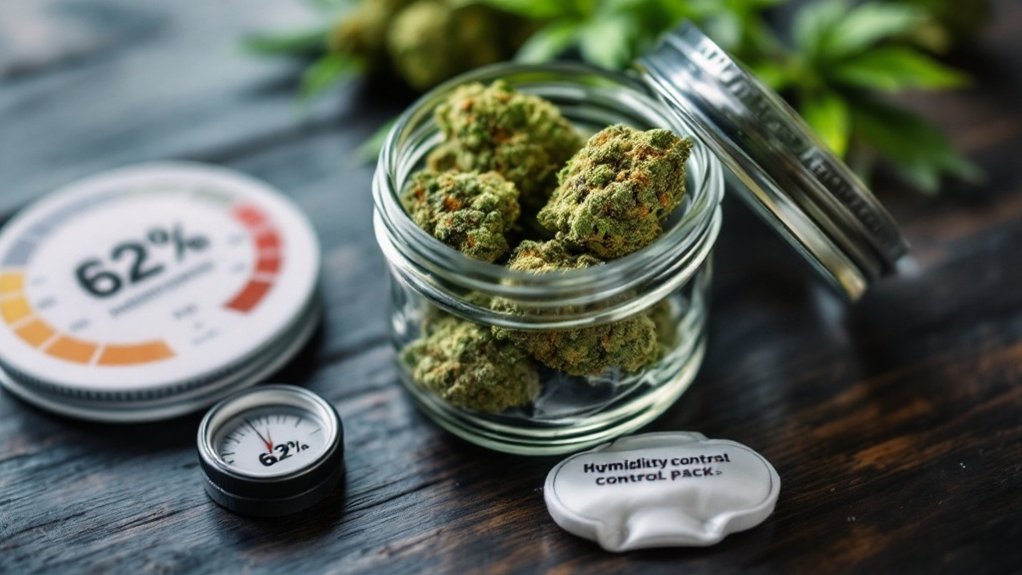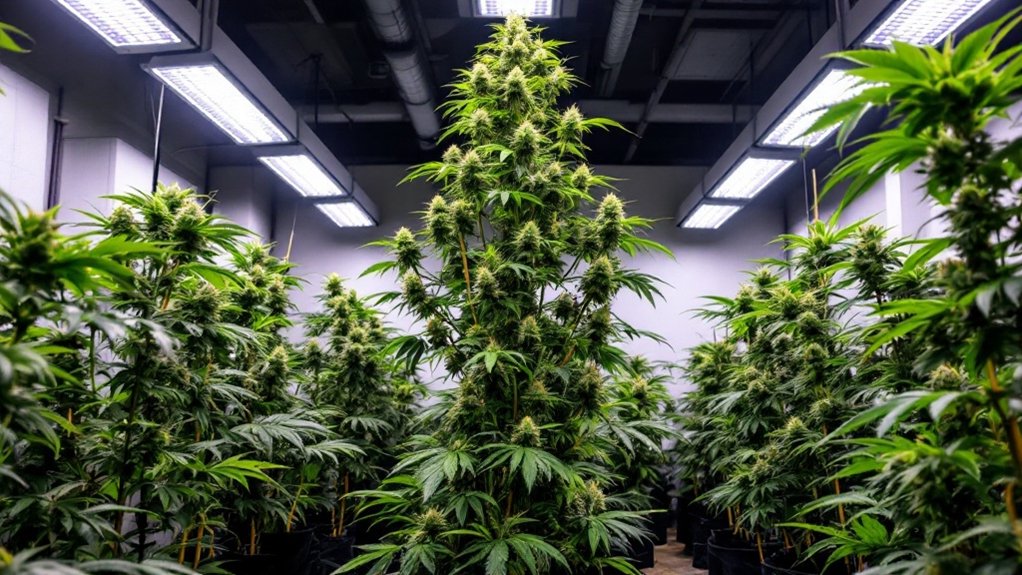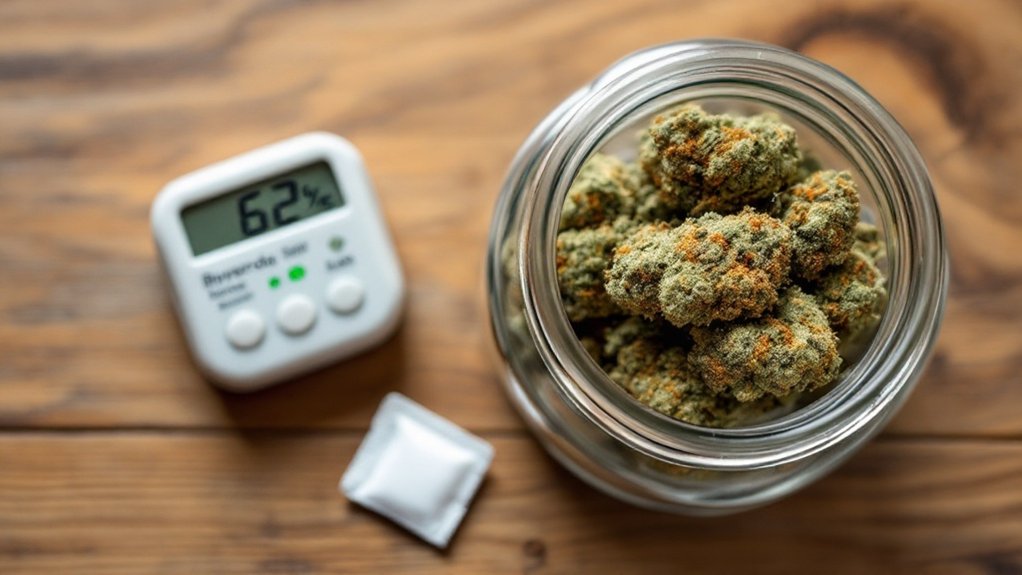To rehydrate cannabis without compromising potency, experts recommend using airtight containers with humidity control packs designed to maintain 55-65% relative humidity. Commercial products like Boveda packs gradually release moisture while preserving delicate cannabinoids and terpenes. Natural alternatives such as orange peels introduce moisture but carry risks of mold and unwanted flavors. Proper monitoring during the process guarantees cannabis reaches the ideal 10-12% moisture content while maintaining its chemical integrity. The science behind moisture equilibrium offers fascinating insights into preservation techniques.

When cannabis becomes too dry, it loses much of its appeal as both texture and potency can deteriorate considerably. Proper rehydration techniques can restore dry cannabis to its ideal condition while preserving its valuable compounds. The process requires attention to detail and an understanding of how moisture interacts with the plant’s delicate chemical structure.
Creating an airtight environment stands as the foundation of successful cannabis rehydration. Mason jars and quality zip-top bags provide the controlled microclimate necessary for even moisture distribution. These sealed containers maintain the perfect 55-65% relative humidity that produces pliable buds with preserved terpene profiles. Improper sealing often leads to inconsistent results or potential mold development, compromising both safety and efficacy.
Commercial humidity control packs have revolutionized cannabis rehydration by providing steady, precise moisture levels. Products like Boveda packs release moisture gradually, protecting the delicate cannabinoid and terpene structures that determine potency and flavor. Overly dried weed typically contains less than 10% moisture content, falling well below the ideal 10-12% range for optimal consumption.
While some users employ natural alternatives such as orange peels or lettuce, these methods introduce additional variables including unwanted flavors and increased mold risk. Traditional remedies like these offer imprecise humidity control and can potentially introduce harmful bacteria to your cannabis.
For those seeking rapid results, the steam method utilizes a hot water pot to produce gentle vapor that rehydrates cannabis without direct water contact. Cannabis placed in a perforated container above steam can quickly regain moisture, though this technique requires vigilant monitoring to prevent overexposure, which may compromise bud structure and diminish aromatic compounds.
Preservation of potency remains paramount throughout the rehydration process. Cannabinoids degrade when exposed to direct light, excessive heat, or moisture, making controlled, gradual rehydration essential. Monitoring buds regularly for texture and aroma helps detect early signs of potential potency loss or excess moisture absorption.
After successful rehydration, proper storage extends the benefits gained. Airtight containers placed in cool, dark environments stabilize humidity levels and prevent unwanted oxidation. Cannabis readily absorbs environmental odors, so isolation from strong-smelling substances maintains flavor purity.
Regular sensory assessment through touch and smell provides ongoing feedback about moisture content. Specialized hygrometers offer precise humidity readings for those seeking data-driven approaches. These instruments allow users to fine-tune their rehydration methods by providing objective measurements rather than relying solely on subjective evaluations, ensuring cannabis maintains ideal moisture content for maximum potency preservation.
Frequently Asked Questions
Can Rehydrated Weed Cause Mold or Health Issues?
Improperly rehydrated cannabis can indeed harbor mold, posing considerable health concerns. When moisture levels exceed 65% humidity or improper techniques are employed, mold spores may proliferate, potentially causing mycotoxicosis when consumed.
Symptoms range from respiratory distress to nausea and sinus inflammation, with immunocompromised individuals facing elevated risks. Even when burned at high temperatures, mold toxins may survive combustion.
Controlling humidity between 55-65% and using airtight glass containers considerably reduces these risks during the rehydration process.
How Long Does Properly Rehydrated Cannabis Stay Fresh?
Properly rehydrated cannabis maintains freshness for six months to one year when stored correctly.
Experts note that ideal conditions include 59-63% humidity levels, airtight glass containers, and cool, dark environments away from sunlight.
Despite ideal storage, cannabis gradually loses its aroma and potency over time as natural degradation occurs.
Temperature stability greatly impacts longevity, with fluctuations accelerating cannabinoid breakdown regardless of how well the rehydration process was initially performed.
Does Rehydration Affect the Terpene Profile or Flavor?
Rehydration markedly affects cannabis terpene profiles, with improper techniques causing substantial flavor degradation.
Terpenes, particularly volatile compounds like myrcene, can evaporate during rapid moisture introduction.
Studies indicate that slow, controlled rehydration in dark, sealed environments preserves more aromatic compounds compared to quick methods.
Temperature control remains critical, as excessive heat accelerates terpene loss.
While properly rehydrated cannabis can regain some aromatic qualities, the flavor intensity typically decreases compared to cannabis that maintained ideal moisture levels throughout the curing process.
Can You Rehydrate Weed Multiple Times?
Multiple rehydration of cannabis is technically possible, experts report, though each cycle introduces increasing risks.
Cannabis can withstand several rehydration attempts, but with diminishing returns as terpenes gradually degrade and moisture fluctuations stress the plant material.
Research indicates that limiting rehydration to 2-3 cycles helps maintain reasonable quality, while monitoring humidity levels between 55-65% remains essential.
Beyond this threshold, consumers may notice significant deterioration in aroma, texture, and potentially face elevated mold risks.
Is It Better to Prevent Drying or Rehydrate Later?
Prevention of cannabis drying is demonstrably superior to rehydration, according to cultivation experts.
While rehydrating cannabis multiple times remains possible, each cycle risks diminished terpene profiles and potency degradation that cannot be fully restored.
Maintaining ideal relative humidity (55-62%) from the outset preserves cannabinoids and trichome integrity, which are vulnerable during rehydration processes.
Storage in airtight containers at temperatures between 60-70°F greatly extends shelf life and maintains therapeutic properties that, once lost through excessive drying, cannot be completely recovered.









